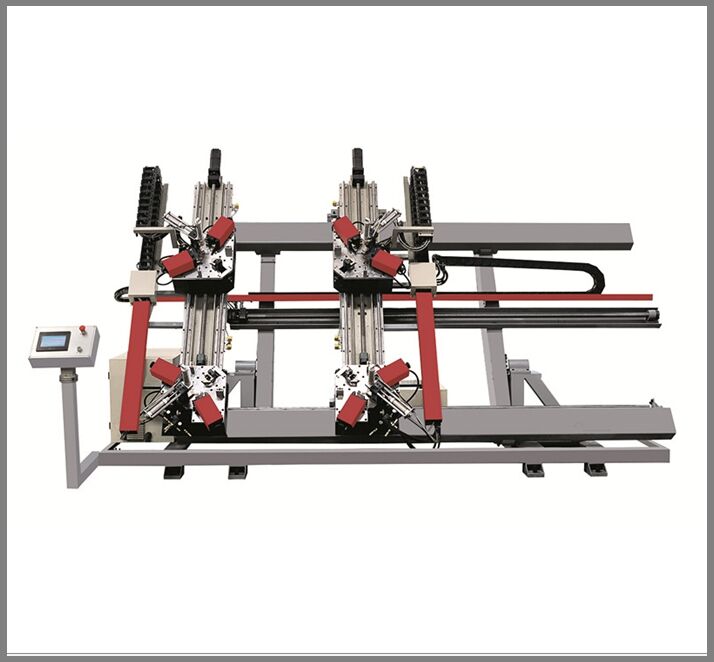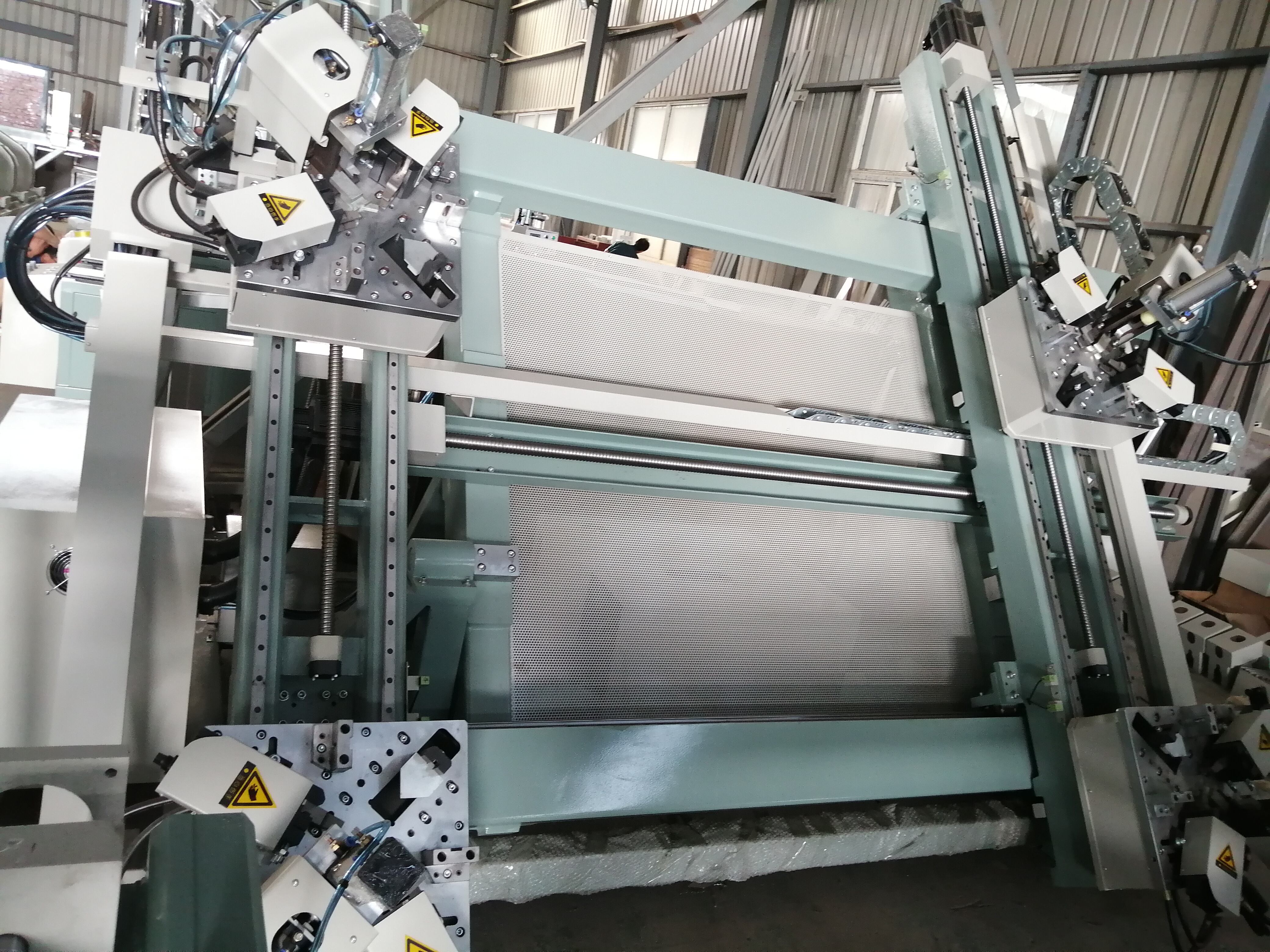5 Essential Features in Modern Window Machines
Top-tier manufacturers now roll out AI in production lines that allow for real-time defect inspection and maintenance forecasting procedures. Machine vision for the inspection of glasses sees 0.1mm level with in-house inspection, waste is reduced by 18% vs manual check, and cuts down defective product and free scale in the production line by 60%, based on International Window Associate (2023). AI also maximizes the use of materials with algorithmic cutting patterns, so that raw materials can be used more efficiently, helping to cut down on material costs.
Energy Efficiency Requirements for Production
Contemporary equipment should to be energy-star certified, while keeping operational costs to a minimum. GLASS HANDLING CONTROL Variable-frequency drives control speeds of our drives for glass-handling, which can decrease energy usage by 22-35% when compared to constant-speed drive options. Thermal breaks in framing members stops heat loss and keeps production area temperature stable with out-hvac over compensating. These attributes allow facilities to satisfy 2024 EPA emissions limits, while also reducing utility expenses.
Precision Engineering Standards (ISO 9001 Benchmark)
ISO 9001-certified machinery guarantees dimensional accuracy through:
- Laser-guided positioning systems maintaining ±0.15mm tolerance
- Vibration-dampening frames eliminating micro-imperfections
- Automated calibration sequences before each production run
This prevents air/water infiltration failures in finished windows while reducing product returns by 29% (Quality Assurance Institute, 2023). Precision engineering directly correlates to 15-year lifespan guarantees on window installations.
Evaluating Production Capacity Requirements for Window Machines

Strategic capacity planning balances throughput needs against operational risks and capital constraints. Industry benchmarks reveal distinct production tiers that inform purchase decisions. Manufacturers must consider forecasted demand cycles, maintenance windows, and scalability pathways when selecting equipment.
Industry Data: Average Throughput Rates (2023 Statistics)
Common window building machines divide into 3 throughputs level according to hourly output amount. Small- to medium-capacity systems, 1-100 units/hour depending on the model available for custom studios. Medium-capacity machines of 100-500 units per hour volume levels for regional suppliers. High-capacity automatic lines entail more than 500 mating parts per hour in the case of an industrial operation. The latter tiers lend themselves to matching projected order volumes with machinery capacity without over-extending.
Scalability Paradox: Over-investment vs Under-capacity Risks
The “Goldilocks” problem of scalability; manufacturers are forced to make a choice between; maintaining overhead cost overrun with high capacity machinery or a system under capacity stalling order fulfilment. This is solved by using modular equipment designs where capacities can be extended stepwise. Manufacturers that implement phased automation reduce upfront capital expenditure by 25-40% and maintain 30% headroom for future throughput.
Smart Technology Integration in Window Machine Selection
Case Study: IoT-Enabled Glass Cutting Systems
It is IoT sensors that are revolutionizing the excellence of glass cutting in the latest generation of windows machines, including for one European manufacturer whose rollout to 2023-2024 is underway.” The system automatically adjusted the blade parameters for different glasses by employing vibration and pressure sensors attached to the equipment and linked through an employee network platform. Waste material was reduced by 27 per cent and cutting accuracy was improved to ±0.15mm tolerance—better than the traditional mechanical systems' ±0.5mm. And with that, production managers now monitor the health of the machine, based on 17 operating parameters, without having to be on site—reducing unplanned downtime by 30% year over year.
Real-time Quality Control Through Machine Learning
At 120 frames per second, computer vision algorithms scrutinize every element of every window as it’s assembled, identifying tiny flaws no human inspector could ever see. Machine learning models, trained millions of defect images, can recognize a sealant gap or misalignment in less than 0.3 seconds — or about 40% faster than human teams. One of the large North American producer employing this technology reported a 65% reduction in customer returns in first year of operation. These platforms self-adjust to changing quality requirements without any manual reprogramming, and that will be key as we move towards the more stringent 2025 energy standards.”
Total Cost of Ownership Analysis Framework
A comprehensive Total Cost of Ownership (TCO) framework is essential for window machine investments, extending analysis beyond immediate purchase prices. Industry data reveals hidden expenditures like energy consumption comprise 30-40% of lifetime expenses, while advanced predictive maintenance reduces annual servicing costs by 45% over reactive models. Manufacturers should calculate:
- Installation and commissioning fees (15-20% of base price)
- Energy efficiency differentials between equipment grades
- Expected repair frequencies during 10-year operational lifespans
- Scrap rate reductions from precision engineering
Modern TCO models factor regulatory compliance costs, projecting energy regulation penalties increasing 7% annually through 2030. This holistic approach prevents budget overruns by quantifying operational realities early in procurement cycles.
ROI Calculation Models for Automated Systems

Automated window machinery demands specialized ROI calculations incorporating productivity multipliers. Contemporary models track:
- Labor cost reductions from integrated robotic assembly (averaging 55% decrease)
- Throughput gains via AI optimization cycles (15-25% output boost)
- Quality improvement savings through defect reduction systems
The most effective ROI frameworks utilize Net Present Value (NPV) projections contrasting automated versus manual workflows. Mid-sized manufacturers report 18-24 month payback periods when automation slashes material waste below 3.5%. Scalable calculation templates must include depreciation schedules, accounting for modular upgrades extending equipment relevance.
Future-Proofing Strategies in Window Machine Purchases
Modular Design Trends in Manufacturing Equipment
In this context, modular designs are now at the forefront of next generation window manufacturing systems, which can be updated incrementally instead of all-or-nothing approaches. By deploying machines with standardized interfaces, plants can replace modules like sealing units or control modules on their own. Not only does this allow for incorporation of next-gen technology without chucking the baby out with the bathwater (which is a key asset when material innovations or design spec changes crop up in the middle of a product's life), but it's also much easier to pull off the kind of design consolidation that many wave-mod product cycles now demand. Fixed-configuration substitutes become obsolescent prematurely and carry 35%-65% in additional long-term ownership costs. Manufacturing suppliers are indicated to have up to a 40% longer equipment production life with material reuse and overall flexibility.
Adapting to Energy Regulation Changes (2025 Projections)
Expected regulation changes are likely to force industrial energy consumption reductions ranging up to 25% on a range of markets by 2025 for production equipment. “Forward-thinking processes avoid the compliance issues by choosing window machinery that is over and above what is required today—especially in motor systems and thermal components. Technologies, such as regenerative drives, transform the braking energy into tradable power, and demand-driven IoT-based load optimization will avoid idle disposal. Smart investments in these kind of systems today are going to be saving you money down the line on the retrofits, as well as on the monthly pricing for that electricity.
Maintenance Requirements Across Different Window Machine Types
Good maintenance is crucial in keeping up to maximum on all types of production machinery. Contemporary approaches have advance far past break/fix where various types of machinery have individual needs: insulated glass line elastomers require a weekly cleaning cycle, CNC cutting systems warrant quarterly calibration checks, and tempering furnaces need monthly thermal sensor verification. Failure modes show that hydraulic press units experience 30% greater downtime than pneumatic systems resulting from fluid contamination, whilst robotic assembly arms are more tolerant when using bi-annual lubrication scheduling.
Predictive Maintenance Technologies Comparison
Predictive technologies now transform maintenance approaches through real-time equipment monitoring:
| Technology | Failure Detection Accuracy | ROI Potential | Implementation Complexity |
|---|---|---|---|
| Vibration Analysis | 89% (ISA 2023) | 27% reduction in unplanned stops | Medium |
| Thermography Scanning | 78% | $15k/yr savings per furnace | Low |
| Ultrasonic Testing | 92% | 40% longer component lifespan | High |
Vibration sensors excel at identifying bearing wear in cutting machines 3-4 weeks before failure, while thermal imaging spots electrical imbalances in welding systems with 95°F+ deviations signaling imminent issues. Operators implementing these methods report 22% lower spare part inventories.
Downtime Cost Analysis per Machine Category
Production stoppages create cascading financial impacts, with costs varying significantly by equipment type:
| Machine Category | Avg. Hourly Downtime Cost | Primary Cost Drivers |
|---|---|---|
| Automated Glass Cutters | $1,240 | Material waste, recalibration |
| IG Sealing Lines | $980 | Sealant spoilage, restart delays |
| Framing Presses | $1,750 | Shift overtime, contract penalties |
Lines most affected by an unplanned stop are those that process glass because of the drift of crystalline alignment which force a full recal description of what adjustments can be made, cal for restart, contributing 2.5 hours to a restart sequence. In contrast, sealing units have a 48% lower restart penalty, but a material replacement cost is incurred if the sealants polymerize prematurely during downtime. For the plants that have redundant protocols, it is shown that critical path machinery is recovered within 63% of original plant time.
FAQ
What is the role of AI in modern window machines?
AI plays a crucial role in modern window machines by facilitating real-time defect inspection and maintenance forecasting, maximizing the use of materials with algorithmic cutting patterns, and enhancing overall production efficiency.
How does energy efficiency impact window machine production?
Energy efficiency in window machines helps reduce operational costs and comply with environmental regulations. Features like variable-frequency drives and thermal breaks contribute to energy savings and environmental impact reduction.
What is the importance of precision engineering in window machines?
Precision engineering ensures dimensional accuracy, reduces product defects, and increases product lifespan, resulting in fewer returns and compliance with quality standards.
How do machine learning algorithms benefit window production?
Machine learning algorithms in window production enhance real-time quality control by quickly identifying defects, reducing customer returns, and adapting to changing quality standards without manual adjustments.
What maintenance is required for different window machine types?
Maintenance varies by machine type: insulated glass lines need weekly cleaning, CNC systems require quarterly checks, and tempering furnaces need monthly verifications. Predictive technologies help optimize maintenance schedules.
Table of Contents
- 5 Essential Features in Modern Window Machines
- Evaluating Production Capacity Requirements for Window Machines
- Smart Technology Integration in Window Machine Selection
- Total Cost of Ownership Analysis Framework
- Future-Proofing Strategies in Window Machine Purchases
- Maintenance Requirements Across Different Window Machine Types
-
FAQ
- What is the role of AI in modern window machines?
- How does energy efficiency impact window machine production?
- What is the importance of precision engineering in window machines?
- How do machine learning algorithms benefit window production?
- What maintenance is required for different window machine types?

